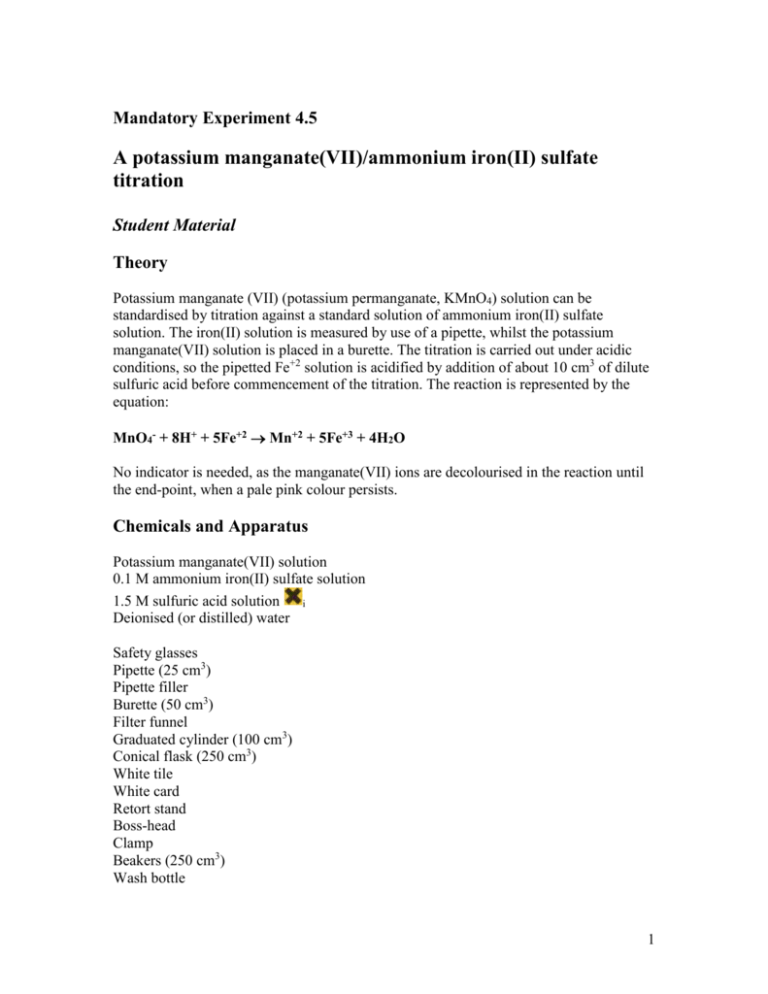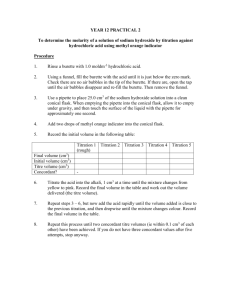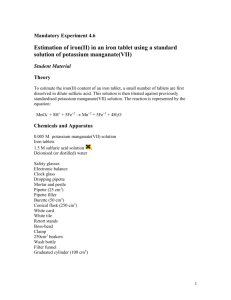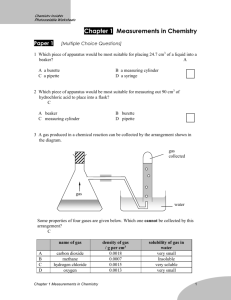ammonium iron(II) sulfate titration
advertisement

Mandatory Experiment 4.5 A potassium manganate(VII)/ammonium iron(II) sulfate titration Student Material Theory Potassium manganate (VII) (potassium permanganate, KMnO4) solution can be standardised by titration against a standard solution of ammonium iron(II) sulfate solution. The iron(II) solution is measured by use of a pipette, whilst the potassium manganate(VII) solution is placed in a burette. The titration is carried out under acidic conditions, so the pipetted Fe+2 solution is acidified by addition of about 10 cm3 of dilute sulfuric acid before commencement of the titration. The reaction is represented by the equation: MnO4- + 8H+ + 5Fe+2 Mn+2 + 5Fe+3 + 4H2O No indicator is needed, as the manganate(VII) ions are decolourised in the reaction until the end-point, when a pale pink colour persists. Chemicals and Apparatus Potassium manganate(VII) solution 0.1 M ammonium iron(II) sulfate solution 1.5 M sulfuric acid solution i Deionised (or distilled) water Safety glasses Pipette (25 cm3) Pipette filler Burette (50 cm3) Filter funnel Graduated cylinder (100 cm3) Conical flask (250 cm3) White tile White card Retort stand Boss-head Clamp Beakers (250 cm3) Wash bottle 1 Procedure NB: Wear your safety glasses. 1 Wash the pipette, burette and conical flask with deionised water. Rinse the burette with the potassium manganate(VII) solution and the pipette with the iron(II) solution. 2 Using a pipette filler, fill the pipette with the iron(II) solution and transfer the contents of the pipette to the conical flask. This solution is acidified by addition of about 10 cm3 of dilute sulfuric acid. 3 Using a funnel, fill the burette with potassium manganate(VII) solution, making sure that the part below the tap is filled before adjusting to zero. Because of the intense colour of potassium manganate(VII) solutions, readings are taken from the top of the meniscus. 2 4 With the conical flask standing on a white tile, add the solution from the burette to the flask. Swirl the flask continuously and occasionally wash down the walls of the flask with deionised water using a wash bottle. 5 The end-point of the titration is detected by the first persisting pale pink colour. Note the burette reading. 6 Repeat the procedure, adding the potassium manganate(VII) solution dropwise approaching the end-point until two titres agree to within 0.1 cm3. 7 Calculate the concentration of the potassium manganate(VII) solution. Table of results Copy this table into your practical report book. Rough titre Second titre Third titre Average of accurate titres Volume of iron(II) solution used in each titration Concentration of iron(II) solution Concentration of potassium manganate(VII) solution = = = = = = = Questions relating to the experiment 1. Why is ammonium iron(II) sulfate suitable as a primary standard? 2. Why is sulfuric acid added to the iron(II) solution prior to titration? Could hydrochloric acid or nitric acid be used instead of sulfuric acid ? Explain. 3. In preparing for the titration, explain (a) why the pipette and burette were rinsed with deionised water followed by a little of the solutions they were to contain, (b) why the conical flask was rinsed with deionised water only. 4. During the titration the sides of the conical flask were washed down with deionised water from a wash bottle. Explain why this procedure is necessary and why it can be carried out without affecting the result of the titration. 5. One of the products of this reaction acts as a catalyst for the reaction. Which product is this? How could you demonstrate what substance is acting as the catalyst? 3 6. Why was sulfuric acid added in making up the ammonium iron(II) sulfate solution? 4 Teacher Material Iron(II) is very susceptible to air oxidation under neutral or alkaline conditions but this oxidation is inhibited in the presence of acids. The ammonium iron(II) sulfate solution is made up in dilute acid solution to make it stable towards air oxidation. If the iron(II) solution were made up in distilled or deionised water, a brown precipitate would result quickly as the iron(II) is oxidised to iron(III). Iron(II) sulfate (FeSO4.7H2O) is available but is not a primary standard. It is not stable in storage as it is susceptible to air oxidation. Often yellow or brown specks can be seen in this material. This is evidence of oxidation of the iron(II) to iron(III). Potassium manganate(VII) is not a primary standard. Even the best grade of solid potassium manganate(VII) is contaminated with manganese(IV) oxide. It is therefore not possible to make up solutions of exact concentration directly from the solid reagent. However solutions can be made up and standardised prior to use. Manganese(IV) oxide, manganese(II) ions, light, heat, acids and bases all catalyse the decomposition of potassium manganate(VII) solutions. If care is taken to minimise the effects of these, a solution can be prepared which has reasonable stability and which need only be standardised occasionally. Standardisation may be carried out as described in the Student Material or by titration against freshly prepared standard sodium ethanedioate solution under acidic conditions at a temperature of 60-80 oC. Potassium manganate(VII) solutions of concentration of the order of 0.02 M are commonly used. An approximately 0.02 M solution of potassium manganate(VII) is an ideal concentration for titration against 0.1 M iron (II) sulfate solutions as they react in a ratio of 1 to 5. Titrations involving potassium manganate(VII) solutions are always carried out under acidic conditions. Acidic conditions are necessary, because in neutral or alkaline conditions Mn+7 is reduced only as far as Mn+4. If conditions are not sufficiently acidic, a muddy brown precipitate containing manganese(IV) oxide results. The amount of acid added is not critical as long as there is enough to provide an acidic medium and a source of H+ ions for the reaction. 5 The normal source of acid used is dilute sulfuric acid. Sulfuric acid is a good source of H+, and the SO4-2 ions are not reactive. Hydrochloric acid would react with the KMnO4, and chlorine gas would be evolved according to the equation: 2MnO4- + 10Cl- + 16H+ 2Mn2+ + 5Cl2 + 8H2O Larger titres than with sulfuric acid would be obtained because of this. Nitric acid is not suitable as it can become involved in redox processes where the NO3- ion is reduced. Smaller titres than with sulfuric acid would be obtained because of this. The end-point of the titration is detected by the first persisting pale pink colour. Even at the end-point the pink colour will fade after a short period as the MnO4ions react with Mn2+ ions, as follows: 2MnO4- + 3Mn2+ + 2H2O 5MnO2 + 4H+ Note that when the first drop of MnO4- solution is added the colour is retained briefly, yet when further additions are made they decolourise immediately. This is evidence that one of the reaction products acts as a catalyst for the reaction. The reaction is catalysed by Mn2+ ions. There are no Mn2+ ions present when the first drop is added, and so the reaction of this drop is slower than further drops, as the catalyst is in place for their addition. This can be verified by taking a clean conical flask, pipetting the Fe2+ solution into it, acidifying it and then before starting to titrate adding some MnSO4 solution (a convenient source of Mn2+). Now the first droplet of MnO4- added decolourises immediately as there is Mn2+ in place to act as catalyst. A fuller description of titration procedure is to be found in the Student Material relating to Mandatory Experiment 4.2. Preparation of reagents 0.1 M ammonium iron(II) sulfate solution: Accurately weigh 39.2 g of ammonium iron(II) sulfate crystals in a small beaker and dissolve them in a small amount of dilute sulfuric acid. Transfer the solution to a 1000 cm3 volumetric flask. Wash out the beaker with deionised water and add the washings to the volumetric flask. Add about 200 cm3 of dilute sulfuric acid to the volumetric flask and then bring the total volume to 1000 cm3 using deionised water. The bottom of the meniscus should be resting on the mark. Stopper the volumetric flask and invert several times. 6 Potassium manganate(VII) solution (approximately 0.02 M): Dissolve about 3.2-3.25 g of the solid reagent in about 1 litre of deionised water, and allow the solution to stand over night. Filter the solution through glass wool in a funnel (this allows oxidation of any organic material and the filtration removes the manganese(IV) oxide formed). The solution should be stored under cool conditions in a clean dark glass bottle. Soap washed bottles may contain traces of organic material and so should not be used. Strictly, the solution should be standardised each time before use, but provided the solution is prepared and stored as indicated the deterioration of the solution is minimal over a period of weeks. Dilute sulfuric acid (approximately 1.5 M): (Always dilute sulfuric acid by adding the acid to water and not the other way round.) 85 cm3 of the concentrated acid is added slowly to about 700 cm3 of deionised water containing about 20 ice cubes. The mixture is stirred and made up to 1 litre in a volumetric flask with deionised water. The flask is stoppered and inverted a number of times. Quantities per working group 200 cm3 potassium permanganate solution (approximately 0.02 M) 200 cm3 0.1 M ammonium iron(II) sulfate solution 100 cm3 1.5 M sulfuric acid Deionised water Safety considerations Safety glasses must be worn. Chemical hazard notes Potassium manganate(VII) n: Solid potassium manganate(VII) is a powerful oxidising agent and should be kept clear of any oxidisable substances. It is harmful and should not be allowed to be inhaled, ingested or come into contact with the skin. Potassium manganate(VII) solution is an oxidising agent and can be a skin irritant. If it is washed off, it may leave a brown stain that will slowly disappear. Ammonium iron(II) sulfate is harmful if ingested in quantity, and is an eye irritant. Dilute sulfuric acid i is harmful to eyes and an irritant to skin. Concentrated sulfuric acid is very corrosive to eyes and skin. Due to its very considerable heat of reaction with water, it is essential that the acid be added to water when it is being diluted. 7 Disposal of wastes Dilute with water, neutralise with anhydrous sodium carbonate and flush to foul water drain with excess water. To dispose of unused potassium manganate(VII) solution, add some dilute sulfuric acid. Using a fume cupboard, add sodium metabisulfite with stirring until the solution is colourless. Dilute with excess water, and flush to foul water drain with excess water. Specimen Results Rough titre Second titre Third titre Average of accurate titres Volume of iron(II) solution used in each titration Concentration of iron(II) solution = 22.8 cm3 = 22.4 cm3 = 22.5 cm3 = 22.45 cm3 = 25.0 cm3 = 0.10 M Specimen Calculations (a) First principles method Volume of Fe(II) solution used Moles of Fe(II) used = 25.0 cm3 = 25.0 x 0.1 / 1000 = 0.0025 moles Balanced equation: MnO4- + 5Fe2+ + 8H+ Mn2+ + 5Fe3+ + 4H2O 1 mole 5 moles 8 moles 1 mole 5 moles 4 moles Moles of MnO4- reacting Volume of MnO4- solution Moles/cm3 of MnO4- used Moles/litre of MnO4- used Concentration of potassium manganate(VII) solution = 0.0025/5 moles = 0.0005 moles = 22.45 cm3 = 0.0005/22.45 = 0.00002227 = 0.02227 = 0.022 M. (b) Formula method VA x MA x nB = VB x MB x nA 22.45 x MA x 5 = 25.0 x 0.1 x 1 MA = 25.0 x 0.1 x 1 / (22.45 x 5) 8 = 0.022 M Concentration of potassium manganate(VII) solution . = 0.022 M. Solutions to student questions 1. Why is ammonium iron(II) sulfate suitable as a primary standard? Because it is stable and available in a highly pure form. 2. Why is sulfuric acid added to the iron(II) solution prior to titration? Could hydrochloric acid or nitric acid be used instead of sulfuric acid? Explain. Acidic conditions are necessary, because in neutral or alkaline conditions Mn+7 is reduced only as far as Mn+4. Hydrochloric acid is not suitable as it would react with the KMnO4, and chlorine gas would be evolved. Nitric acid is not suitable as it is itself a very powerful oxidising agent - the NO3- ion is readily reduced. 3. In preparing for the titration, explain (a) why the pipette and burette were rinsed with deionised water followed by a little of the solutions they were to contain, (b) why the conical flask was rinsed with deionised water only. (a) Deionised water washes out any residual solutions in the burette and pipette respectively. The second step was taken to remove any residual water, and so avoid dilution of the solutions when they are added to the burette and pipette respectively. (b) Deionised water washes out any residual solution in the conical flask. If it were then washed out with the solution it was to contain, traces of it would remain, and there would not be a precisely known amount of the solution in the flask. 4. During the titration the sides of the conical flask were washed down with deionised water from a wash bottle. Explain why this procedure is necessary and why it can be carried out without affecting the result of the titration. The washing process was carried out to ensure that all of the manganate(VII) solution added from the burette reacted with the iron(II) solution. It did not affect the result of the titration because only deionised water was added – no extra reactants were introduced into the flask. 5. One of the products of this reaction acts as a catalyst for the reaction. Which product is this? How could you demonstrate what substance is acting as the catalyst? The reaction is catalysed by Mn2+ ions. This can be shown by taking a clean conical flask, pipetting the Fe2+ solution into it, acidifying it and then before 9 starting to titrate adding some MnSO4 solution (a convenient source of Mn2+). Now the first droplet of MnO4- added decolourises immediately as there is Mn2+ in place to act as catalyst. 6. Why was sulfuric acid added in making up the ammonium iron(II) sulfate solution? Iron(II) is very susceptible to air oxidation, forming iron(III), under neutral or alkaline conditions but this oxidation is inhibited in the presence of acids. The ammonium iron(II) sulfate solution is made up in dilute acid solution to make it stable towards air oxidation. 10







